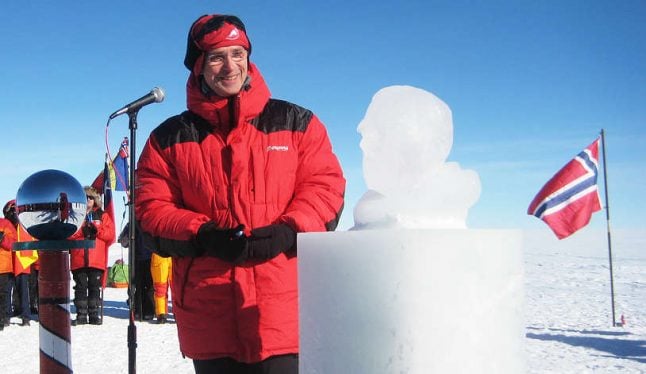On December 14th, 1911, not long before the outbreak of World War I as nationalism was on the rise in Europe, Norwegian explorer Roald Amundsen and the four members of his team were the first to arrive at the southernmost tip of the globe, planting a Norwegian flag at the pole to mark their epic victory over British adventurer Robert Scott, who would perish on the return journey.
"We are here to celebrate one of the most outstanding achievements of mankind," Norwegian Prime Minister Jens Stoltenberg said during the ceremony, according to a copy of his remarkds provided by his office.
Stoltenberg becomes only the second government chief to ever set foot on the South Pole, following the 2007 visit by then prime minister of New Zealand Helen Clark.
"And we are here to highlight the importance of this cold continent for the warming of the globe," he added in his speech to adventurers and the scientists stationed at the giant US Amundsen-Scott base camp, today located right next to the geographic pole.
A couple of hundred people of different nationalities had decided to meet at the pole to celebrate the 100th anniversary of its conquest, including a number of Norwegian adventurers aiming to repeat their compatriots' exploit on skis.
A number of them however were forced to hitch a plane ride to cover the final distance and make it to the ceremony on time, due to poor weather conditions.
Stoltenberg took the opportunity to highlight the problem of climate change and the particular challenge it poses in Antarctica.
"The Antarctic continent has been changing more rapidly in recent years than at any time in the past 800 years," Stoltenberg said in his speech, cautioning that "the loss of ice in Antarctica can have dramatic global effects."
If the Antarctic ice sheet were to melt completely — something that would not happen for centuries even under the worst case global warming scenarios — scientists say it would boost sea levels by about five metres.
That would lead the ocean to flood numerous coastal cities and swallow up many small island nations.
During the short ceremony, which was partially broadcast in Norway, Stoltenberg, like Amundsen before him, planted a Norwegian flag in the ice, and also unveiled an ice sculpture of his famous compatriot.
"That's the man," he said, uncovering the bust.
Having swapped his usual suit and tie for a warm red and black anorak, the prime minister also skied the final kilometres to the pole in temperatures about 30 degrees Celsius below freezing, tracing the route taken by Amundsen and his team a century ago.
Stoltenberg was not however accompanied by sleddogs — seen as the key to Amundsen's success over Scott, who made the mistake of using ponies for his expedition — since dogs and all foreign species besides humans have been banned from Antarctica since 1994 to avoid introducing foreign diseases to the icy continent.
The ill-fated British naval officer and his team were not forgotten at Wednesday's ceremony.
"Scott and his team paid the ultimate price… Their names will forever be inscribed in Polar history," Stoltenberg said, hailing "their courage and determination in reaching one of the most inhospitable places on earth."
After reaching the pole on January 17th, 1912, more than a month after the Norwegian expedition, Scott and four of his compatriots died on their return journey, falling victim to extreme cold, exhaustion and starvation.
Scott's body, and those of his two team members, were found in their tent, buried under the snow, in November 1912.
Amundsen also completed a historic crossing of the Northwest Passage in 1903-1906. In 1926 he was part of an expedition to have reached the North Pole aboard a blimp, the first verified and uncontested attainment of the pole.
He died two years later on a mission to rescue Italian explorer Umberto Nobile who had piloted the airship to the North Pole.



 Please whitelist us to continue reading.
Please whitelist us to continue reading.
Member comments